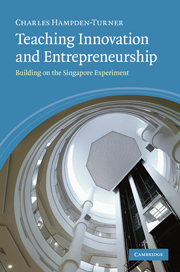Book contents
- Frontmatter
- Contents
- List of grids
- List of dilemmas
- Acknowledgements
- Introduction
- 1 Singapore’s challenge
- 2 The entrepreneurial ecosystem
- 3 How can innovative pedagogies be measured?
- 4 Co-defining innovative education
- 5 The Singapore results
- 6 Results of the Mandarin-speaking programme
- 7 Reconciling values
- 8 ‘It is only the Hawthorne Effect’
- 9 The programme that cannot stand still
- 10 Innovation and the future of the university
- 11 What are the implications of being able to teach innovation?
- 12 Is a new creative class arising?
- Notes
- Bibliography
- Appendices
- General index
- Index of dilemmas and reconciliations
2 - The entrepreneurial ecosystem
a programme like no other
Published online by Cambridge University Press: 05 July 2014
- Frontmatter
- Contents
- List of grids
- List of dilemmas
- Acknowledgements
- Introduction
- 1 Singapore’s challenge
- 2 The entrepreneurial ecosystem
- 3 How can innovative pedagogies be measured?
- 4 Co-defining innovative education
- 5 The Singapore results
- 6 Results of the Mandarin-speaking programme
- 7 Reconciling values
- 8 ‘It is only the Hawthorne Effect’
- 9 The programme that cannot stand still
- 10 Innovation and the future of the university
- 11 What are the implications of being able to teach innovation?
- 12 Is a new creative class arising?
- Notes
- Bibliography
- Appendices
- General index
- Index of dilemmas and reconciliations
Summary
You do not teach technopreneurship within a confined space bounded by classroom walls. Of course, some instruction occurs there. It is convenient, but at least half the time is spent crossing real or metaphorical bridges to other realms. A famous psychological test of creativity is the Remote Associations Test. The subject has to take two ideas, values or resources previously remote from one another and associate these in his/her mind. In other words, to create and to innovate you need to connect highly contrasting phenomena, so contrasting that no one connected them before.
If innovation comes about by combining a great diversity of resources then students must go in search of such diversity. But we are not speaking simply of crossing oceans and continents, although that may be necessary, but of finding when you get there a variety of cultures, political systems, life-styles and values. It is a serious mistake to regard diversity as ‘a good thing’, for reasons explained in Box 2.1. Diversity by itself has no reliable meaning. We need to see that with all values there is an implied contrast with an opposite value and a possibility to combine the two or to exclude either one.
Ecosystems are characterized by the richness of their variety, like a coral reef which makes a habitat for a thousand species of tropical fish, undersea flora and crustaceans, living among coral insects in an azure sea. The amazing colours encourage mate selection, so the beauty is self-sustaining and exists as one harmonious whole. It was the purpose of this programme to contrive an ecosystem rich in value differences and full of opportunities to combine contrasting ideas. Let loose among such colourful elements, the urge to innovate is spontaneous.
- Type
- Chapter
- Information
- Teaching Innovation and EntrepreneurshipBuilding on the Singapore Experiment, pp. 22 - 42Publisher: Cambridge University PressPrint publication year: 2009



